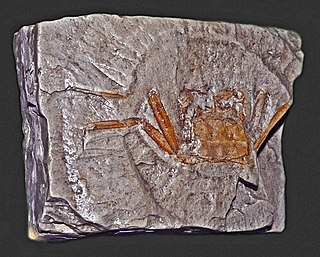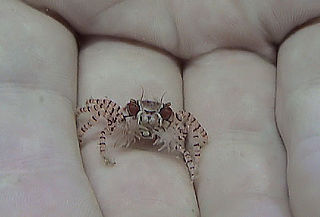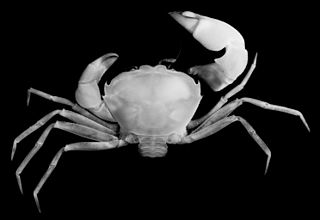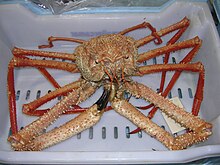
Xanthidae is a family of crabs known as gorilla crabs, mud crabs, pebble crabs or rubble crabs. Xanthid crabs are often brightly coloured and are highly poisonous, containing toxins which are not destroyed by cooking and for which no antidote is known. The toxins are similar to the tetrodotoxin and saxitoxin produced by puffer fish, and may be produced by bacteria in the genus Vibrio living in symbiosis with the crabs, mostly V. alginolyticus and V. parahaemolyticus.

Xanthoidea is a superfamily of crabs, comprising seven families. Formerly, a number of other families were included in Xanthoidea, but many of these have since been removed to other superfamilies. These include Carpilioidea, Eriphioidea, Hexapodoidea, Pilumnoidea and Trapezioidea. Even in this reduced state, Xanthoidea remains one of the most species-rich superfamilies of crabs.

Retroplumidae is a family of heterotrematan crabs, placed in their own (monotypic) superfamily, Retroplumoidea.

The thumbnail crab, Thia scutellata, is a species of decapods, in the family of thiidae, whose carapace resembles a human thumbnail, a dense fringe of long hairs distinctly notched around the edge. Pale pink in colour with red to brown markings. It is found in the North Sea, north-east Atlantic and Mediterranean Sea. It is the only extant species in the genus Thia, although two fossil species are known. Their predators includes the atlantic cod.

Dromiidae is a family of crabs, often referred to as sponge crabs. They are small or medium-sized crabs which get their name from the ability to shape a living sponge into a portable shelter for themselves. A sponge crab cuts out a fragment from a sponge and trims it to its own shape using its claws. The last two pairs of legs are shorter than other legs and bend upward over the crab's carapace, to hold the sponge in place. The sponge grows along with the crab, providing a consistent shelter.

Lybia is a genus of small crabs in the family Xanthidae. Their common names include boxer crabs, boxing crabs and pom-pom crabs. They are notable for their mutualism with sea anemones, which they hold in their claws for defense. In return, the anemones get carried around, which may enable them to capture more food particles with their tentacles. Boxer crabs use at least three species of anemones, including Bundeopsis spp. and Triactis producta. The bonding with the anemone is not needed for survival, however, and boxer crabs have frequently been known to live without them, sometimes substituting other organisms such as sponges and corals for the sea anemones.

Homolodromiidae is a family of crabs, the only family in the superfamily Homolodromioidea. In contrast to other crabs, including the closely related Homolidae, there is no strong linea homolica along which the exoskeleton breaks open during ecdysis. The family comprises two genera, Dicranodromia, which has 18 species, and Homolodromia, with five species.

Hexapodidae is a family of crabs, the only family in the superfamily Hexapodoidea. It has traditionally been treated as a subfamily of the family Goneplacidae, and was originally described as a subfamily of Pinnotheridae. Its members can be distinguished from all other true crabs by the reduction of the thorax, such that only seven sternites are exposed, and only four pairs of pereiopods are present. Not counting the enlarged pair of claws, this leaves only six walking legs, from which the type genus Hexapus, and therefore the whole family, takes its name. Some anomuran "crabs", such as porcelain crabs and king crabs also have only four visible pairs of legs. With the exception of Stevea williamsi, from Mexico, all the extant members are found either in the Indo-Pacific oceans, or around the coast of Africa.

Percnon gibbesi is a species of crab. It is one of at least two species commonly called Sally Lightfoot, and is also referred to as the nimble spray crab or urchin crab. It has been described as "the most invasive decapod species to enter the Mediterranean".

Pseudozioidea is a superfamily of crabs, formerly treated in the Eriphioidea, Carpilioidea, Xanthoidea, Pilumnoidea and Goneplacoidea. A number of fossils from the Eocene onwards are known from the family Pseudoziidae. Eleven genera are recognised in three families:

Homola barbata is a species of crab in the family Homolidae.
Drachiella is a genus of crabs in the family Aethridae, containing one fossil species, and the following species:

Leucosiidae is a family of crabs containing three subfamilies and a number of genera incertae sedis:

Paromola cuvieri is a species of crab in the family Homolidae, the carrier crabs. It occurs in the eastern Atlantic Ocean and the Mediterranean Sea, from Angola to Norway, the Northern Isles and Iceland. It is demersal, occurring at depths of 10–1,212 metres (33–3,976 ft), but it is primarily found deeper than 80 m (260 ft). It prefers areas with mud and emerging rocks, and has been observed in deep-water coral gardens and sponge aggregations. It is locally common.
Danièle Guinot is a French biologist, an emeritus professor at the Muséum national d'histoire naturelle in France, known for her research on crabs.

Rochinia is a genus of crab in the family Epialtidae, containing the following species:

Mathildellidae is family of crabs belonging to the superfamily Goneplacoidea, containing the following genera:

Paromola is a genus of crabs within the family Homolidae. Members of the Homolidae genus have their fifth pereiopods in a sub-dorsal position, which allows them to hold objects, such as sponges, black corals and gorgonians, over the rear half of the carapace, in a possible defence mechanism against predators.

Gordonopsis is a genus of deep-sea porter crabs in the family Homolidae. The Homolidae are also known as carrier crabs or porter crabs for their fifth pereiopods, which they use to hold objects in place over the rear half of the carapace in a possible defence mechanism against predators. Species of Gordonopsis are found in deep waters of the Indo-West Pacific region. The genus was erected in 1995 by Danièle Guinot and Bertrand Richer de Forges.















